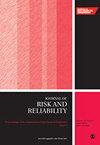An improved active Kriging method for reliability analysis combining expected improvement and U learning functions
IF 1.8
4区 工程技术
Q3 ENGINEERING, INDUSTRIAL
Proceedings of the Institution of Mechanical Engineers Part O-Journal of Risk and Reliability
Pub Date : 2023-06-02
DOI:10.1177/1748006x231174666
引用次数: 0
Abstract
The reliability assessment of structures with multiple failure modes and small failure probability is challenging due to the time-consuming simulations required. Active learning Kriging methods for structural reliability with multiple failure modes have shown high computational efficiency and accuracy. However, selecting the appropriate sample and its failure mode to update the Kriging models remains a key problem. In this paper, we propose a new learning function and stopping criterion to further improve the efficiency of structural system reliability analysis. Firstly, we propose a new learning function that combines the expected improvement function and the U learning function. This function selects the most suitable samples, balancing the degree of expected improvement of samples to the limit state surface and the degree of misclassification probability of samples. Secondly, we propose a new stopping criterion that considers both the accurate construction of limit state surfaces and the probability of accurately predicting the signs of samples. This criterion avoids premature or late termination of the active learning process. Thirdly, the sequential MCS simulation method is employed in the active learning process to efficiently evaluate small failure probability problems. By analyzing four examples, we verify the accuracy and efficiency of the proposed structural reliability analysis method.结合期望改进和U学习函数的改进主动Kriging可靠性分析方法
多失效模式和小失效概率结构的可靠性评估具有挑战性,因为需要花费大量时间进行仿真。主动学习Kriging方法在多种失效模式下的结构可靠性计算中显示出较高的计算效率和精度。然而,选择合适的样本及其失效模式来更新克里格模型仍然是一个关键问题。为了进一步提高结构系统可靠性分析的效率,本文提出了一种新的学习函数和停止准则。首先,我们提出了一个新的学习函数,它结合了期望改进函数和U学习函数。该函数选择最合适的样本,平衡样本对极限状态面的期望改善程度和样本的错分类概率程度。其次,我们提出了一个新的停止准则,该准则考虑了极限状态曲面的准确构造和准确预测样本符号的概率。这个标准避免过早或迟终止主动学习过程。第三,在主动学习过程中采用序贯MCS仿真方法,有效地评估小失效概率问题。通过对四个实例的分析,验证了所提出的结构可靠度分析方法的准确性和有效性。
本文章由计算机程序翻译,如有差异,请以英文原文为准。
求助全文
约1分钟内获得全文
求助全文
来源期刊

Proceedings of the Institution of Mechanical Engineers Part O-Journal of Risk and Reliability
ENGINEERING, MULTIDISCIPLINARY-ENGINEERING, INDUSTRIAL
CiteScore
4.50
自引率
19.00%
发文量
81
审稿时长
6-12 weeks
期刊介绍:
The Journal of Risk and Reliability is for researchers and practitioners who are involved in the field of risk analysis and reliability engineering. The remit of the Journal covers concepts, theories, principles, approaches, methods and models for the proper understanding, assessment, characterisation and management of the risk and reliability of engineering systems. The journal welcomes papers which are based on mathematical and probabilistic analysis, simulation and/or optimisation, as well as works highlighting conceptual and managerial issues. Papers that provide perspectives on current practices and methods, and how to improve these, are also welcome
 求助内容:
求助内容: 应助结果提醒方式:
应助结果提醒方式:


